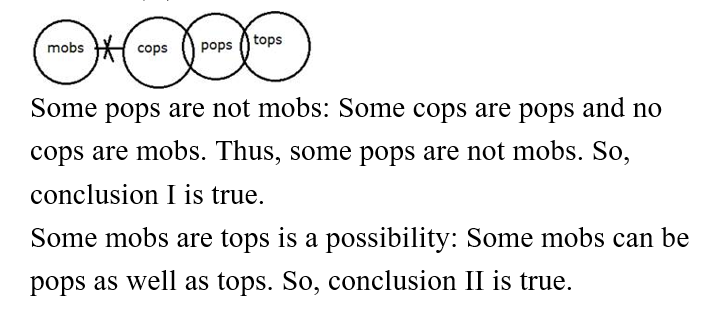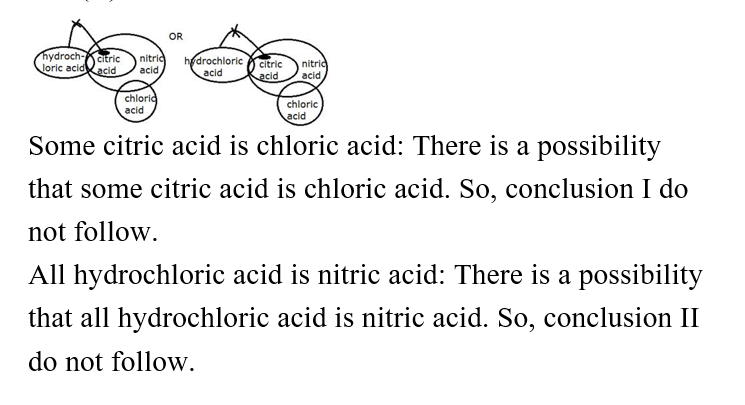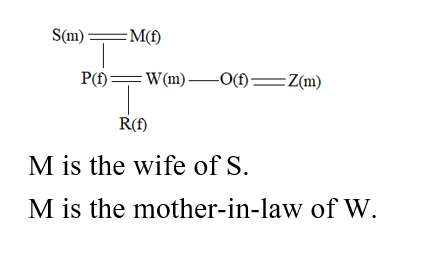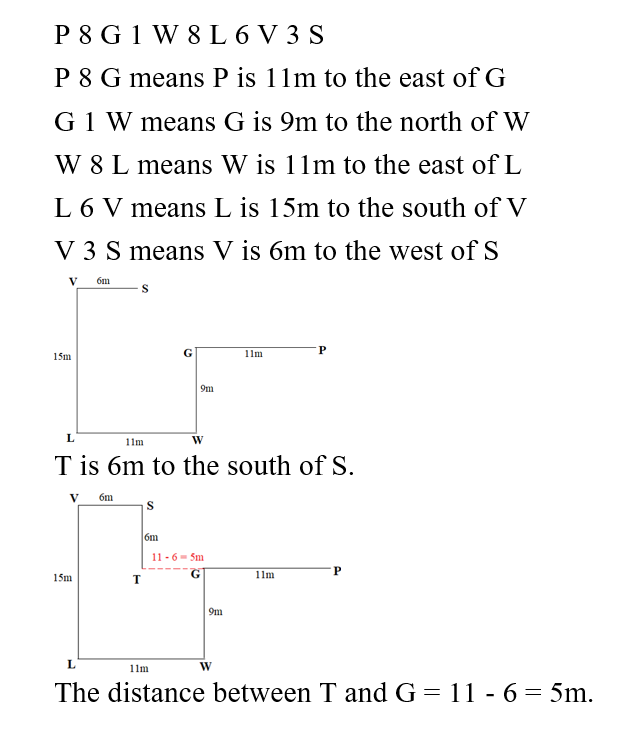Question 1:
In a certain code language, "fast moving cars" is coded as "4e d7 hm", "cars in the space" is coded as "tk 3z 2b 4e", "the smart move" is coded as "5v 2w 3z". What will be the code for "fast"?
एक निश्चित कोड भाषा में "fast moving cars" को "4e d7 hm" के रूप में कोडित किया जाता है, "cars in the space" को "tk 3z 2b 4e" के रूप में कोडित किया जाता है तथा "the smart move" को "5v 2w 3z" के रूप में कोडित किया जाता है, तो "fast" के लिए कोड क्या होगा?
Question 2:
In the question given below, three statements are given followed by two conclusions. You have to take the given statements to be true even if they seem to be at variance from commonly known facts. Read the conclusions and decide which of the given conclusions logically follows from the given statements disregarding the commonly known facts.
नीचे दिए गए प्रश्न में तीन कथन और उसके बाद दो निष्कर्ष दिए गए हैं। आपको दिए गए कथनों को सत्य मानना है, भले ही वे सर्वज्ञात तथ्यों से भिन्न प्रतीत हों। निष्कर्षों को पढ़िए और निर्धारित कीजिए कि दिए गए निष्कर्षों में से कौन-सा निष्कर्ष सामान्य रूप से ज्ञात तथ्यों की अवहेलना करते हुए दिए गए कथनों का तार्किक रूप से अनुसरण करता है।
कथन: कोई कॉप्स, मॉब्स नहीं है।
Statements: No cops are mobs.
Some tops are pops. कुछ टॉप्स, पोप्स हैं।
Some cops are pops. कुछ कॉप्स, पोप्स हैं।
निष्कर्ष: I. कुछ पोप्स, मॉब्स नहीं हैं।
Conclusions: I. Some pops are not mobs
II. Some mobs are tops is a possibility कुछ मॉब्स के टॉप्स होने की संभावना है।
Question 3:
In the question given below, three statements are given followed by two conclusions. You have to take the given statements to be true even if they seem to be at variance from commonly known facts. Read the conclusions and decide which of the given conclusions logically do not follow from the given statements disregarding the commonly known facts.
नीचे दिए गए प्रश्न में तीन कथन और उनके बाद दो निष्कर्ष दिए गए हैं। आपको दिए गए कथनों को सत्य मानना है, भले ही वे सर्वज्ञात तथ्यों से भिन्न प्रतीत हों। निष्कर्षों को पढ़िए और निर्धारित कीजिए कि दिए गए निष्कर्षों में से कौन-सा/से निष्कर्ष सामान्य रूप से ज्ञात तथ्यों की अवहेलना करते हुए दिए गए कथनों का तार्किक रूप से अनुसरण नहीं करता/करते है/हैं।
कथन: सभी सिट्रिक एसिड, नाइट्रिक एसिड हैं
Statements: All citric acid is nitric acid.
केवल कुछ सिट्रिक एसिड, हाइड्रोक्लोरिक एसिड हैं
Only a few citric acid is hydrochloric acid.
कुछ क्लोरिक एसिड, नाइट्रिक एसिड हैं
Few chloric acid is nitric acid.
निष्कर्ष: I. कुछ सिट्रिक एसिड, क्लोरिक एसिड हैं
Conclusions: I. Some citric acid is chloric acid.
II. All hydrochloric acid is nitric acid. सभी हाइड्रोक्लोरिक एसिड, नाइट्रिक एसिड हैं
Question 4:
In the question given below, two statements are given followed by conclusions: I, II and III. You have to take the given statements to be true even if they seem to be at variance from commonly known facts. Read the conclusions and decide which of the given conclusions logically follows from the given statements disregarding commonly known facts.
नीचे दिए गए प्रत्येक प्रश्न में दो कथन तथा उनका अनुसरण करते हुए तीन निष्कर्ष संख्यांकित I, II और III दिये गए हैं। आपको दिए गए कथनों को सत्य मानना है, भले ही वे आमतौर पर ज्ञात तथ्यों से भिन्न हों। निष्कर्षों का अध्ययन करें और निर्धारित करे कि दिए गए निष्कर्षों में से कौन-सा निष्कर्ष सामान्यतः ज्ञात तथ्यों की अवहेलना करते हुए तर्कसंगत रूप से दिए गए कथनों का अनुसरण करता है।
कथन: केवल कुछ राइस, वाइट है।
Statements: Only a few rice is white.
Some cups are white. कुछ कप, वाइट हैं।
निष्कर्ष: I. सभी कप कभी भी वाइट नहीं हो सकते हैं।
Conclusions: I. All cups can never be white.
II. Some whites are definitely not cups. कुछ वाइट निश्चित रूप से कप नहीं हैं।
III. All rice can never be white. सभी राइस कभी भी वाइट नहीं हो सकते हैं।
Question 5:
In the question given below, two statements are given followed by two conclusions. You have to take the given statements to be true even if they seem to be at variance from commonly known facts. Read the conclusions and decide which of the given conclusions logically follows from the given statements disregarding the commonly known facts.
नीचे दिए गए प्रश्न में दो कथन और उसके बाद दो निष्कर्ष दिए गए हैं। आपको दिए गए कथनों को सत्य मानना है, भले ही वे आमतौर पर ज्ञात तथ्यों से भिन्न हों। निष्कर्षों को पढ़ें और निर्धारित करें कि दिए गए निष्कर्षों में से कौन-सा निष्कर्ष सामान्यतः ज्ञात तथ्यों की अवहेलना करते हुए तर्कसंगत रूप से दिए गए कथनों का अनुसरण करता है।
कथन: केवल कुछ क्रैक, फ्रैक्चर हैं।
Statements: Only a few cracks are fractures
Some fractures are break कुछ फ्रैक्चर, ब्रेक हैं।
निष्कर्ष: I. कुछ क्रैक, ब्रेक हैं।
Conclusions: I. Some cracks are break
II. None of the cracks are break कोई भी क्रैक, ब्रेक नही हैं।
Question 6:
निर्देश: सात सदस्यों M, O, P, R, S, W और Z वाले एक परिवार में तीन पीढ़ियाँ और तीन पुरुष हैं। किसी व्यक्ति के या तो माता-पिता दोनों जीवित हैं या दोनों में से कोई भी जीवित नहीं है। O, P की सिस्टर-इन-लॉ है और P, M की पुत्री है। Z, R का चाचा है और उसका विवाह O से हुआ है। W और O परिवार में एकमात्र सहोदर हैं। S, W का ससुर है और W, P का/की पति/पत्नी है।
Directions: In a family of seven members M, O, P, R, S, W and Z there are three generations and three males. Either both or none of the parents of a person are alive. O is sister-in-law of P, who is the daughter of M. Z is uncle of R and is married to O. W and O are the only siblings in the family. S is the father-in-law of W, who is the spouse of P.
How R is related to M? R, M से किस प्रकार संबंधित है?
Question 7:
निर्देश: सात सदस्यों M, O, P, R, S, W और Z वाले एक परिवार में तीन पीढ़ियाँ और तीन पुरुष हैं। किसी व्यक्ति के या तो माता-पिता दोनों जीवित हैं या दोनों में से कोई भी जीवित नहीं है। O, P की सिस्टर-इन-लॉ है और P, M की पुत्री है। Z, R का चाचा है और उसका विवाह O से हुआ है। W और O परिवार में एकमात्र सहोदर हैं। S, W का ससुर है और W, P का/की पति/पत्नी है।
Directions: In a family of seven members M, O, P, R, S, W and Z there are three generations and three males. Either both or none of the parents of a person are alive. O is sister-in-law of P, who is the daughter of M. Z is uncle of R and is married to O. W and O are the only siblings in the family. S is the father-in-law of W, who is the spouse of P.
Four of the following are related to each other in some way and thus form a group, which of the following does not belong to that group?
निम्नलिखित में से चार किसी न किसी प्रकार से एक दूसरे से संबंधित हैं और इस प्रकार एक समूह बनाते हैं, निम्नलिखित में से कौन-सा व्यक्ति उस समूह से संबंधित नहीं है?
Question 8:
निर्देश: सात सदस्यों M, O, P, R, S, W और Z वाले एक परिवार में तीन पीढ़ियाँ और तीन पुरुष हैं। किसी व्यक्ति के या तो माता-पिता दोनों जीवित हैं या दोनों में से कोई भी जीवित नहीं है। O, P की सिस्टर-इन-लॉ है और P, M की पुत्री है। Z, R का चाचा है और उसका विवाह O से हुआ है। W और O परिवार में एकमात्र सहोदर हैं। S, W का ससुर है और W, P का/की पति/पत्नी है।
Directions: In a family of seven members M, O, P, R, S, W and Z there are three generations and three males. Either both or none of the parents of a person are alive. O is sister-in-law of P, who is the daughter of M. Z is uncle of R and is married to O. W and O are the only siblings in the family. S is the father-in-law of W, who is the spouse of P.
Which of the following information is true regarding M?
M के संबंध में निम्नलिखित में से कौन-सी सूचना सत्य है?
i) M is the wife of S. M, S की पत्नी है।
ii) W and O are the children of M. W और O, M की संतान हैं।
iii) M is the mother-in-law of W. M, W की सास है।
Question 9:
Study the following information and answer the following question:
निम्नलिखित जानकारी का अध्ययन करें और निम्नलिखित प्रश्न का उत्तर दें:
A 1 B का अर्थ A, B के 9m उत्तर में है।
A 3 B का अर्थ A, B के 6m पश्चिम में है।
A 6 B का अर्थ A, B के 15m दक्षिण में है।
A 8 B का अर्थ A, B के 11m पूर्व में है।
यदि P 8 G 1 W 8 L 6 V 3 S है
A 1 B means A is 9m to the north of B.
A 3 B means A is 6m to the west of B.
A 6 B means A is 15m to the south of B.
A 8 B means A is 11m to the east of B.
If P 8 G 1 W 8 L 6 V 3 S
T, S के 6m दक्षिण में है, तो T और G के बीच की दूरी कितनी होगी?
T is 6m to the south of S, then what will be the distance between T and G?
Question 10:
In the question relationship between different elements is shown in the statements. The statement is followed by two conclusions. Choose the correct option.
प्रश्न में विभिन्न तत्वों के बीच के संबंध को कथनों में दर्शाया गया है। कथन के बाद दो निष्कर्ष दिए गए हैं। सही विकल्पका चयन कीजिए।
Statement: कथन: L ≤ J < O = H, K = P ≥ I > O
Conclusion: निष्कर्ष: I. P > L II. H < K








